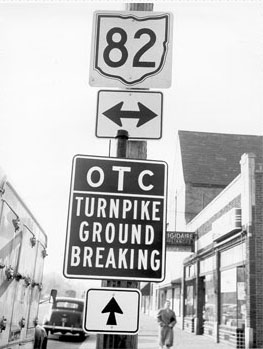FROM BABYLON TO WESTGATE: A HISTORY OF THE OHIO TURNPIKE
The Ohio Turnpike is actually a modern version of an ancient form of travel. Toll roads are at least 2,700 years old. Tolls had to be paid by travelers using the Susa-Babylon Way during the 7th century B.C. Many modern European roads were originally constructed as toll roads in order to recoup the cost of construction and maintenance.
Following the Revolutionary War (1783), and most particularly the victory of General “Mad” Anthony Wayne over the Indians at Fallen Timber in 1794, western migration increased dramatically as citizens of the new republic began settlement of the Ohio or Northwest Territory. In 1802 congress inserted into the Ohio statehood bill a provision for the construction of a National Road from the eastern seaboard across the new state.
In time, the new road eased travel for horsemen, buggies and Conestoga wagons on their way west. A toll of two cents per every 10 miles was charged for horses. Additional tolls were charged for buggies and wagons, depending on their expected wear-and-tear on the roadway.
Over the years, more new roads were created as the population of Ohio grew. With the coming of the automobile, dirt roads and wooden bridges gave way to macadam, then asphalt, and then to concrete surfaces and spans of steel. Even so, by the mid-20th century something more was needed.
The postwar boom meant increased enterprise in Ohio. Farmers and manufacturers needed a fast and dependable way to transport their products to market. Motorists demanded speedier routes to distant cities, shopping centers and recreational sites. Existing roadways were choked with traffic. A dramatic solution was needed.
UNDER CONSTRUCTION
 Ohio’s leaders envisioned a nonstop superhighway across the state, superior to anything that had ever been built. In 1949, the legislature authorized creation of the Ohio Turnpike Commission. To fund the new superhighway, the Commission issued $326 million in revenue bonds. The Turnpike would be the biggest construction project in Ohio’s history at that time.
Ohio’s leaders envisioned a nonstop superhighway across the state, superior to anything that had ever been built. In 1949, the legislature authorized creation of the Ohio Turnpike Commission. To fund the new superhighway, the Commission issued $326 million in revenue bonds. The Turnpike would be the biggest construction project in Ohio’s history at that time.
 Ground was broken on October 27, 1952. At peak construction, 10,000 workers were on the job using more than 2,300 bulldozers, graders, loaders and other road building equipment. Building the 241-mile highway took only 35 months.
Ground was broken on October 27, 1952. At peak construction, 10,000 workers were on the job using more than 2,300 bulldozers, graders, loaders and other road building equipment. Building the 241-mile highway took only 35 months.
On October 1, 1955, the massive project was completed. Opening Day traffic totaled 44,000 vehicles. The Ohio Turnpike was in business. In 1956, the first full year of operation, some 10 million cars and trucks used the Turnpike. In 2012, that number had climbed to more than 49.8 million vehicles.
THE MAN BEHIND THE NAME
 The Ohio Turnpike is officially named the James W. Shocknessy Ohio Turnpike, for the agency’s first chairman. A prominent attorney known for his civic endeavors, Mr. Shocknessy devoted his extraordinary talents and energies into making the Turnpike dream a reality.
The Ohio Turnpike is officially named the James W. Shocknessy Ohio Turnpike, for the agency’s first chairman. A prominent attorney known for his civic endeavors, Mr. Shocknessy devoted his extraordinary talents and energies into making the Turnpike dream a reality.